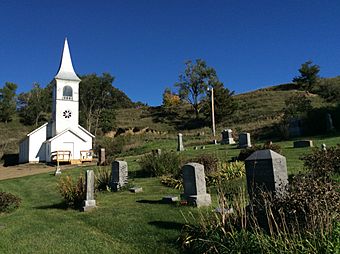Ingemann Danish Lutheran Church facts for kids
The Ingemann Danish Lutheran Church, also known as the Lower Danish Church, is an old and important building located near Moorhead, Iowa, in the United States. This church and its nearby cemetery were added to the National Register of Historic Places in 2001, meaning they are special historical sites.
Quick facts for kids |
|
|
Ingemann Danish Evangelical Lutheran Church and Cemetery
|
|
 |
|
| Location | 32044 County Road E54 |
|---|---|
| Nearest city | Moorhead, Iowa |
| Area | 2.5 acres (1.0 ha) |
| Built | 1884 |
| Built by | Andrew J. Simonson |
| Architectural style | Late Victorian |
| NRHP reference No. | 12000779 |
| Added to NRHP | September 10, 2012 |
Contents
The Church's Early Days
The area west of Moorhead was home to many Danish immigrants. Because so many Danes lived there, people called the place "Dane Hollow."
In 1882, a pastor named G.B. Christiansen started the Ingemann Lutheran church group. At first, they held their church services in a local school or in people's homes.
The church was named after Bernhard Severin Ingemann. He was a famous Danish writer and poet. He was known for writing hymns that focused on general spiritual ideas.
The church building itself was finished in 1884. John and Anna Marie Johnson, who came from Hedensted, Denmark, gave the land for the church. They donated 20 acres of land. This was enough space for the church, a cemetery, a parsonage (the pastor's house), and other small buildings.
The original church was a simple white building with a gable roof. Later, in 1904, Andrew J. Simonsen designed and built the church's front entrance and tower.
The Cemetery and Its People
The first person buried in the church cemetery was Christina (Beck) Swanson in 1884. She was the wife of Neals P. Swanson.
Like many others buried there, she had moved to the United States from Denmark. Most of these immigrants arrived between the 1880s and early 1890s.
Many of the Danish immigrants in Dane Hollow came from places like Horsens and Klakring. However, they also came from other parts of Jutland and some Danish islands. A few people buried in the cemetery were originally from Sweden. They either moved to Denmark before coming to America or married Danes.
A Church Divides and Reunites
In 1894, the Ingemann Church experienced a split. The pastor and some members left to form a new church called Bethesda Lutheran Church. This split was part of a larger disagreement happening within the Danish Lutheran Church at the time.
After the split, Ingemann Church became a Grundtvigian congregation. It became known as the "Lower Danish Church" because it was located in a valley. The new Bethesda Church became an Inner Mission congregation. It was called the "Upper Danish Church" because it was on a hill about a mile south of Ingemann.
Church services at Ingemann were held in the Danish language until 1918. That year, Iowa Governor William L. Harding made a rule. He said that foreign languages could not be used in public places. This included over the telephone, in schools, and during church services.
Around the same time, the Ingemann congregation became too small to have its own pastor. So, services were reduced to only once a month.
In 1948, Ingemann and Bethesda churches decided to join together. Pastor F.W. Thomsen led this new combined congregation. They built a new Bethesda Church in Moorhead. They used good wood saved from the old Bethesda Church, which was taken down. The last baptism and confirmation ceremonies at Ingemann Church happened in 1954.
Preserving History
Today, the historic Ingemann Danish Lutheran Church is cared for by the Ingemann Danish Lutheran Church Preservation Society. The church property is now 2.5 acres. This area includes the church building and the cemetery.
The church is still used for special events. Services are held on Memorial Day. The church also hosts reunions and a few weddings.



